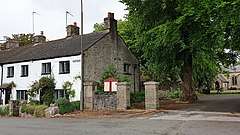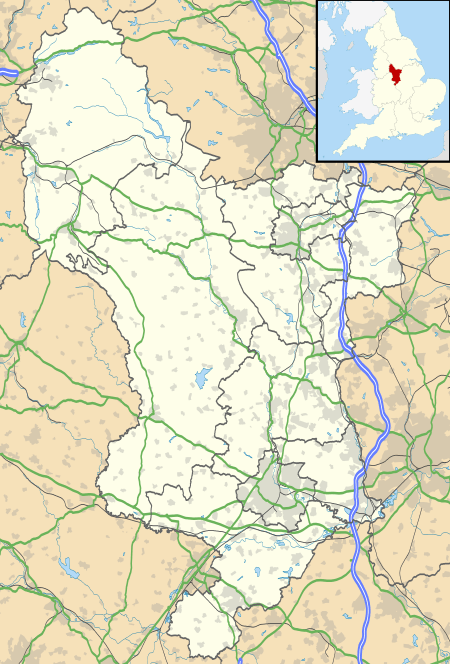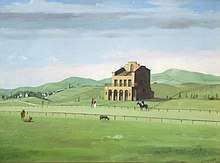Fairfield, Derbyshire
Fairfield is a district of Buxton in Derbyshire, located on the A6 road half a mile to the north east of the town centre.[1] The historic village of Fairfield was centred around a village green (known as 'the Green'). The name Fairfield derives from the Germanic faeger feld meaning 'fair open land', because of its good volcanic soil for pasture. Cistercian monks and Benedictine nuns founded monastic granges at Fairfield in the early 1200s AD (Nunsfield Farm still exists). In the 13th century Fairfield (being north of the River Wye) was within the Royal Forest of Peak, a hunting ground for the king. Fairfield was a chapelry in the parish of Hope (whereas Buxton was in the Bakewell parish). Fairfield and Buxton shared a medieval corn mill on the Wye in Mill Dale, where Ashwood Park is now. Fairfield became a town in its own right, complete with town council. The township covered the land north of the River Wye, including The Park and Devonshire Park, until 1859 when a boundary change moved them into Buxton town. Fairfield remained an urban sanitary district until 1894 and in 1917 it became part of Buxton Urban District Council. In 1811, 1821 and 1831, the chapelry of Fairfield returned a population of 482 inhabitants in the national censuses.[2][3][4]

| Fairfield | |
|---|---|
 St Peters Road | |
 Fairfield Location within Derbyshire | |
| OS grid reference | SK066740 |
| District | |
| Shire county | |
| Region | |
| Country | England |
| Sovereign state | United Kingdom |
| Post town | Buxton |
| Postcode district | SK17 |
| Police | Derbyshire |
| Fire | Derbyshire |
| Ambulance | East Midlands |
The first chapel was built in Fairfield between 1240 and 1255. Fairfield Church was built in c.1595 and was demolished in 1838 to be replaced by the present St. Peter's (Church of England). Lying just north of the 'Green', the church was built in 1839, designed by William Swan, the village schoolmaster. St Peter's is a Grade II listed building.[5] John Wesley visited Fairfleld in September 1784. Fairfield Wesleyan chapel on Waterswallows Road was built in 1868, replacing the first Methodist chapel which was erected in 1844. After 1887 it was used as the Fairfield Local Board Town Hall.[2]

Fairfield Common was established centuries ago as common grazing land. Buxton Racecourse was laid out on the common in the early 1800s. From 1821 horse racing and cock fighting meetings were held each year in June. The Duke of Devonshire commissioned a grandstand building which stood in the 1830s. In 1835 The Commercial Directory for Derbyshire wrote that an "excellent round course has been formed where horse races take place".[4] Buxton raceourse closed in 1840 and the grandstand was pulled down.[6] Buxton and High Peak Golf Club was founded in 1887, after a nine-hole course was laid out on Fairfield Common in 1886.[7] The course was extended to 18 holes in 1893. The 9th par 5 hole is called Standside, which refers to where the grandstand once stood. The Roman road between Aquae Arnemetiae (Roman Buxton) and Melandra fort (near Glossop) runs along the western wall of Fairfield Common.[2]
The Bull's Head pub on Fairfield Road replaced the previous one which was demolished in 1903.[2]
Fairfield is at the head of the narrow dry gorge of Cunningdale, which is part of the Wye Valley Site of Special Scientific Interest (SSSI).[8]
George Kitchen, the Everton, West Ham United and Southampton goalkeeper, was born in Fairfield in 1876. He died in 1965.[9]
References
- OL24 White Peak area (Map). 1:25000. Explorer. Ordnance Survey. West sheet.
- Leach, John (1987). The Book of Buxton. Baracuda Books Limited. pp. 28, 39–48, 84–97, 130–133. ISBN 0 86023 286 7.
- Langham, Mike (2001). Buxton: A People's History. Carnegie Publishing. ISBN 1-85936-086-6.
- Pigot & Co (1835) The Commercial Directory for Derbyshire
- Historic England. "Church of St Peter (1257973)". National Heritage List for England. Retrieved 5 June 2020.
- Roberts, Alan (2012). Buxton Through Time. Amberley Publishing. p. 76. ISBN 978 1 4456 0817 4.
- "The Buxton and High Peak Golf Club". Buxton and High Peak Golf Club. Retrieved 5 June 2020.
- "The Wye Valley SSSI" (PDF). Natural England. Retrieved 31 March 2020.
- "George Kitchen". Spartacus Educational. Retrieved 5 June 2020.